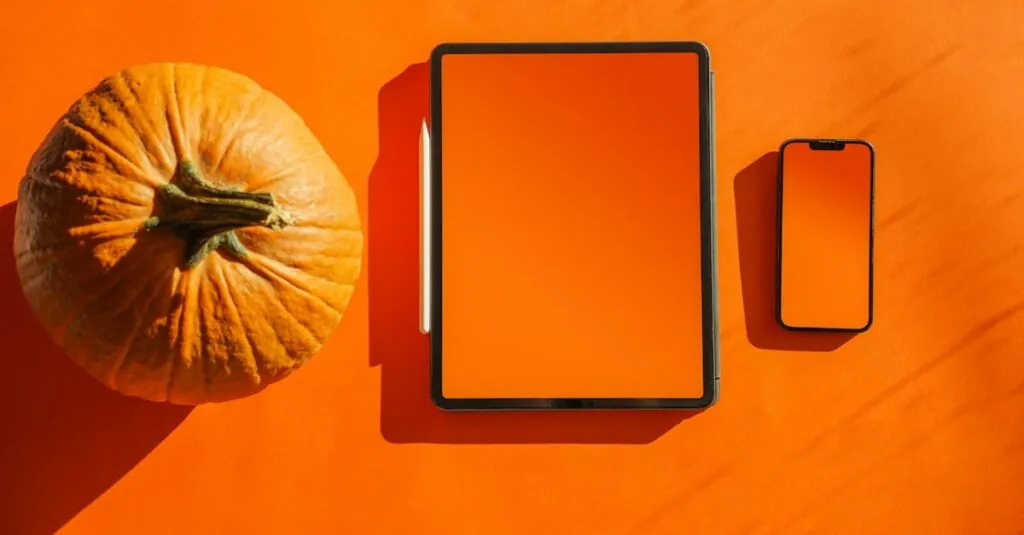Ever looked at your iPhone screen and thought, “This shade of gray could use a little pizzazz?” You’re not alone. Many users find themselves wanting to switch things up, whether to ease eye strain or just to match their mood. Thankfully, changing the display color on an iPhone is as easy as swiping right on a dating app.
Table of Contents
ToggleUnderstanding Display Color Settings
Changing the display color settings enhances the iPhone experience. Users can adjust colors to suit their preferences or needs.
Importance of Display Color
Display color significantly affects user interaction. It helps reduce eye strain, especially during prolonged usage. Personalized colors can improve mood and overall satisfaction with the device. Studies show that blue light can disrupt sleep cycles; adjusting display colors accordingly may aid sleep. Enhanced colors also help users better distinguish between different apps or notifications.
Overview of Color Modes
iPhones offer multiple color modes to cater to different preferences. The standard mode provides vivid colors, while Night Shift reduces blue light exposure in the evening. True Tone automatically adjusts the display based on ambient lighting, enhancing visibility. Users can also explore Color Filters, which assist those with color blindness. These settings ensure that every user can find the optimal display configuration for their needs.
Changing Display Color in Settings
Adjusting display color settings on an iPhone enhances user experience and promotes comfort during use. Follow these steps to access and modify color settings effectively.
Accessing Display Settings
To access display settings, open the Settings app on the iPhone. Scroll down and select Display & Brightness. This menu provides options to adjust brightness, True Tone, and Night Shift. Tapping on Night Shift allows users to schedule warmer colors for evening use, reducing blue light exposure. Returning to the main menu enables direct access to Accessibility settings, which lead to further color adjustments.
Selecting Color Filters
Color filters offer additional customization for display colors. Head into Settings, select Accessibility, and then tap Display & Text Size. Scroll until you find Color Filters and toggle the switch to enable them. Various options appear, including grayscale and color tint. Choose a specific filter to suit personal preferences or visual needs. Adjust the intensity and hue to create a display environment that feels right and improves comfort.
Using Accessibility Features
Adjusting display color using accessibility features enhances user comfort and visual experience. Users can easily access these features to tailor their iPhone display settings.
Enabling Color Filters
To enable color filters, navigate to Settings, then tap Accessibility. Next, select Display & Text Size, followed by Color Filters. Toggle the switch to turn on color filters. Users can choose from options like Grayscale, Red/Green Filter, or Blue/Yellow Filter. Activating these filters helps those with color vision deficiencies customize their display according to their needs.
Customizing Color Filter Options
For customizing color filter options, after enabling the filters, select the desired filter type. Adjust the intensity by moving the slider. Users can also tweak colors by adjusting the hues available for each filter. This personalization ensures that users find the right combination to reduce eye strain or enhance readability. Always test different combinations to identify what feels most comfortable for the specific viewing conditions.
Adjusting Night Shift and True Tone
Adjusting Night Shift and True Tone enhances the iPhone display for comfort and eye health.
Setting Up Night Shift
To set up Night Shift, users can access Settings, then Display & Brightness. After tapping Night Shift, enable the feature by switching the toggle on. Users may choose to use the scheduled option to automatically adjust colors at sunset or set a custom time range. Adjust the color temperature by sliding the bar toward “Less Warm” or “More Warm” to find the ideal warmth for evening use. Night Shift reduces blue light exposure, making it easier to relax before bedtime.
Enabling True Tone
Enabling True Tone adjusts the display to match ambient lighting conditions for more natural visuals. Users should go to Settings, then Display & Brightness. From there, they can toggle on True Tone. Once activated, the display automatically adapts based on surrounding light levels. This feature helps maintain accurate colors in various lighting situations, enhancing overall viewing comfort. True Tone can improve clarity, especially in environments with shifting light sources.
Troubleshooting Common Issues
Users may encounter various display color issues on their iPhones. These problems could stem from settings configurations or software updates. For example, a display might appear overly bright or too dim in certain lighting conditions. Checking the brightness level in Settings under Display & Brightness often resolves such concerns. Users can also toggle Night Shift on and off to see immediate changes in color temperature. If colors appear distorted, going into Settings and adjusting the Color Filters can help restore normal viewing.
Display Color Issues
Display color issues can arise unexpectedly. Colors may seem incorrect due to accessibility settings incorrectly configured. Users should inspect the Color Filters option under Accessibility to ensure proper settings are applied. Problems might also occur after software updates, which sometimes reset display preferences. Confirming that True Tone and Night Shift are enabled can enhance color accuracy based on ambient light. If the screen still seems off, reverting to the factory settings might be necessary to eliminate persistent issues.
Resetting Display Settings
Resetting display settings can restore default configurations. Users navigating to Settings, then General, and selecting Reset can reset all settings. This action won’t erase personal content, just customization. Restarting the device after resetting can also help the changes take effect. If users still experience color problems, performing a complete device update checks for the latest fixes. Keeping the iOS updated often includes patches for display issues, ensuring a smoother experience.
Changing the display color on an iPhone is a straightforward way to enhance user experience and comfort. By utilizing features like Night Shift and True Tone users can significantly reduce eye strain and improve their overall mood. Customizing color filters not only benefits those with color vision deficiencies but also allows everyone to create a personalized viewing experience.
With easy access to these settings through the Settings app users can quickly adapt their devices to suit their needs. Regularly updating iOS ensures that users have the latest tools and fixes at their fingertips. Embracing these options can lead to a more enjoyable and healthier interaction with their iPhone.








